 The set up for the classic musical comedy Dames (1934) introduces us to Ezra (Hugh Herbert), the only wealthy member of the family, who wants to give his counsin Matilda (Zazu Pitts) ten million dollars, under certain conditions. He won't do it if he assesses Matilda's husband Horace (Guy Kibbee) as an immoral man, morality being everything to a judgemental nutter like Ezra.
The set up for the classic musical comedy Dames (1934) introduces us to Ezra (Hugh Herbert), the only wealthy member of the family, who wants to give his counsin Matilda (Zazu Pitts) ten million dollars, under certain conditions. He won't do it if he assesses Matilda's husband Horace (Guy Kibbee) as an immoral man, morality being everything to a judgemental nutter like Ezra.
An aging couple like Matilda & Horace never got into any trouble of any kind before this, but now that's paramount that they avoid all temptation, that's when things begin to look dicey.
Horace is terrified of being judged unworthy by Ezra, who has already disinherited Jimmy (Dick Powell) for taking to the sinful stage. Ezra doesn't yet know that Barbara (Ruby Keeler), the old couple's daugher, is in love with Jimmy, & is herself tempted by the stage. As Jimmy's her thirteenth-cousins so it's okay they're looking toward being a little bit inbred.
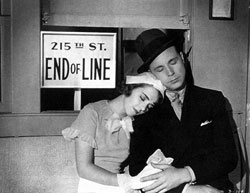 Ezra's obsession with morality makes it worrisome that he's spending the night with Horace & Matilda, especially since Horace has made the acquaintance a frightening sexy showgirl, Mabel (Joan Blondell). Ezra's obsession with morality makes it worrisome that he's spending the night with Horace & Matilda, especially since Horace has made the acquaintance a frightening sexy showgirl, Mabel (Joan Blondell).
Mabel enjoys making Horace look like he's more attached to her than was ever the case. And Ezra wouldn't be apt to believe everything was totally innocent even if Mabel would stop pretending otherwise. She'll only stop if she's paid to go away, so when it comes right down to it, she's a little blackmailer.
Meanwhile Jimmy is trying to get his musical produced. He finds a backer, Harold Ellsworthy Todd (Berton Churchill), but Todd's a crook & they're saved from the scoundrel by Mabel, whose blackmail project corners Horace into being the show's angel. Mabel gets a major role out of the deal, & frankly, Horace gets to have a very good time & would love everything about it if not for the threat of being found out by Ezra.
 A grateful Jimmy sings "Try to See It My Way" to Mabel. Though it's not a bad song, it's not great either. Most of the music was provided by Harry Warren & Al Dubin in the 42nd Street mode, but "Try to See it My Way" is by Allie Wrubel & Mort Dixon. A grateful Jimmy sings "Try to See It My Way" to Mabel. Though it's not a bad song, it's not great either. Most of the music was provided by Harry Warren & Al Dubin in the 42nd Street mode, but "Try to See it My Way" is by Allie Wrubel & Mort Dixon.
He'd previously, on the ferry, sung a teaser bit of "I Only Have Eyes for You" to Barbara, his voice sweet & pure & perfect for seduction, so when she sees him singing for Mabel too, she has a jealous snit & misreads everything.
"Try to See it My Way" will later be sung again by Joan Blondell during the prolonged climax of big numbers, though her main showy song will be "The Girl at the Ironing Board." Bondell sings her own material in Dames though in other musicals she gets dubbed. She sells the ironing board number pretty well because it's kind of a silly vaudeville thing not requiring a pure sweet voice like Ruby Keeler's or Dick Powell's. The puppetry done with the hanging laundry is joyfully silly.
Plot complications accumulate, mostly for the comedy of it all. Then it's opening night on Broadway for Jimmy's musical Sweet & Hot. Plans are affot to disrupt the opening because Ezra has hired a passel of homeless men & gotten them tuxedoes & tickets to opening night. Upon his signal they're to toss rotten fruit at the stage.
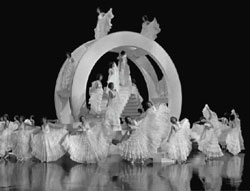 This mean-spirited plan is due to Ezra's high dudgeon in discovering so many members of his clan are involved in the theater, which is just sinful. This mean-spirited plan is due to Ezra's high dudgeon in discovering so many members of his clan are involved in the theater, which is just sinful.
However, up there in the private box with Horace & Matilda, he's getting drunker & drunker because his "health elixer" is ninety-seven percent alcohol. He's against liquor, but health elixers are fine. His cousins eager to agree with Ezra in all things are drinking right along with him.
The "Only Have Eyes" extravaganza starts small with a street scene outside the theater with Jimmy singing to Barbara in a crowd. As with nearly all Busby Berkley fantasy choreography, none of this could really be done on a s tage, & this particular bit would even require the entire theater audience to follow the cast around town before it even ends up on the stage. And, of course, the affectation of it being stageable is what makes Busby Berkley such an outrageous delight.
The song & its settings become increasingly complex, until the crowds surrounding our couple, Jimmy & Barbara, vanish as if by magic.
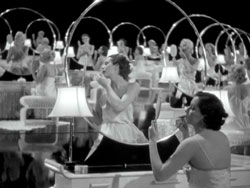 Soon there's a stage of dancing giant heads of Ruby Keller, scores of representatations of her face in choreographed motion. When Ruby as Barbara finally appears in person amidst the representations, all the chorus girls who appear alongside her are Ruby Keeler! Soon there's a stage of dancing giant heads of Ruby Keller, scores of representatations of her face in choreographed motion. When Ruby as Barbara finally appears in person amidst the representations, all the chorus girls who appear alongside her are Ruby Keeler!
This is some of Busby Berkeley's craziest stuff, clearly aimed at honoring the beauty specifically of Ruby Keleer to such heights of excess that she was reportedly just a little embarrassed by the worshipfulness bestowed upon her. It is perhaps the greatest homage to one woman's beauty ever choreographed or filmed.
The next big bit is structured around "Those Beautiful Dames," a mammoth arrangement fantastically choreographed with beautiful dames waking up en masse in their beds. The beds become part of the choreography. Then the girls do their morning excercises en masse; they put on their make-up en masse; & so on, all with furniture as well as women part of the remarkable images that unfold one after another.
It's such fabulous camp it's a wonder Busby Berkley wasn't in his private life a drag queen. It hardly seems possible a regular joe could see women in such unreal exaggeration.
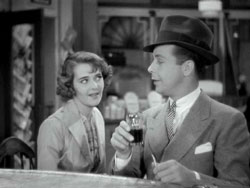 Then comes the full-on drill-team choreography for sacheting, exercising, swooping, tap dancing, with always a sea of gals before our eyes. And de rigour for Busby, there's a series of overhead shots for Busby's trademark kaleidoscope gals. Then comes the full-on drill-team choreography for sacheting, exercising, swooping, tap dancing, with always a sea of gals before our eyes. And de rigour for Busby, there's a series of overhead shots for Busby's trademark kaleidoscope gals.
The fourth number will be Mabel singing "Try to See it My Way," disrupted by the tomato-tossing bums, even though by then Ezra's so snockered in private box above that he's finally admitting to loving the show. He hadn't intentionally given the hired homeless bums the signal to start tossing, but they saw the signal even so, & attempt to ruin everything.
The resultant rioting induces a police raid & everyone including Ezra end up in a drunk tank. Ezra's by now completely won over & finally in his "moral" life finding out about happilness. He's just having had so darned much fun, & has changed his notions of morality. The final joke is that the publicity generated by the theater riot & police raid will keep the show going a full year. Oh, & lovers are forever reunited.
The one-reel short subject And She Learned About Dames (1934) was a promotional film for the musical comedy Dames, & was included among the delightful array of extras on the Criterion set of Busby Berkeley musicals.
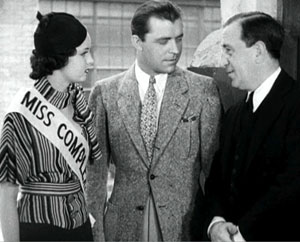 Martha Howson (Martha Merrill) is attending Rovina Finishing School in New York. Martha Howson (Martha Merrill) is attending Rovina Finishing School in New York.
These so-called school girls are none given cast credits, but were selected for this promotion from the chorus line in Dames, & weren't credited for their roles in that either. They all appear in sundry musicals of the decade, but not a one ever broke out of the chorus for credited roles, let alone starring roles.
The girls have sent their photos to a contest for the most perfect complexions, run by the Claybury Soap Company.
Such contests really existed, & viewers in the '30s probably understood, though it's unstated, that the winning face who became Miss Complexion would be used in soap ads. Martha additionally wins a trip trip to Warner Brothers studio in Hollywood.
Lyle Talbot is assigned to show her around the sets. She sees dancers practicing, & runs into sundry cast members from Dames, including Guy Kibbee & Hugh Herbert. She sees Busby Berkeley high up a crane & Ruby Keeler tap dancing. Busby comes down to say hi to Miss Howson & talks to her about beautiful women & the gigantic sets he's using.
Martha's permitted to see clips of the film still iln progress, turning the short subject at least partially into a mere trailer for Dames. Throughout, Martha's most excited about the chance to meet Dick Powell. When she's finally in his presence, she finagles a kiss.
Ultimately And She Learned About Dames is only an ad & not much of a story in itself. It could've passed as a "true" story of some winner of an actual contest for beautiful girls. Curiously even as a semi-fictional tale the "prize" was just a trip to Hollywood, when it might've posited as a chance to be one of the chorus girls, especially as Martha Merrill really was one of them. The fictional Martha Howson evidently wasn't.
The star of this nine-minute advertisement was destined to spend a scant two years in Hollywood filling out the chorus lines of several musicals, major & minor. This short subject was her very first film, & was to remain the only starring role she ever had.
Starring roles in short subjects were given new actors as a step up from screen tests. They amounted to examinations to assess potential star power. Martha Merrill must've failed the exam, as she never did break out the background cast. In just about all her handful of film appearances she is considered even for so little as a screen credit. It's slightly sad to think what high hopes she must've had when given the lead in her very first film, however short it was, only to realize afterward this was to remain the height of her success.
 Made by Moondog Pictures as an extra for a special dvd release of Dames, the short documentary Dames: Busby Berkley's Kaleidoscopic Eyes (2006) focuses largely on the extravagant "I Only Have Eyes for You" sequence of Busby's film to illuminate his methods & "vision."
Made by Moondog Pictures as an extra for a special dvd release of Dames, the short documentary Dames: Busby Berkley's Kaleidoscopic Eyes (2006) focuses largely on the extravagant "I Only Have Eyes for You" sequence of Busby's film to illuminate his methods & "vision."
It's a mediocre documentary with snippets of commentary from film scholars, director John Waters, & sundry experts. Their opinions are spliced between clips from Dames a mite randomly.
A little bit of Busby's personal history creeps in, but not much. It's pretty much the same information you'd get from any two-paragraph thumbnail portrait of Busby's career, including the waning years when drunkenness & failed marriages brought him low.
A "theme" slowly unfolds from the chaotic editing of uneven commentaries, so that the main subject discussed begins to appear to be the kalaidoscope arrangements of chorus girls in Busby's overhead shots. It's short enough to not bore one to death, though it comes pretty close.
copyright © by Paghat the Ratgirl
|
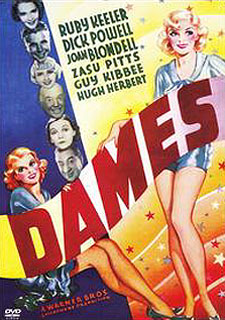

 Ezra's obsession with morality makes it worrisome that he's spending the night with Horace & Matilda, especially since Horace has made the acquaintance a frightening sexy showgirl, Mabel (Joan Blondell).
Ezra's obsession with morality makes it worrisome that he's spending the night with Horace & Matilda, especially since Horace has made the acquaintance a frightening sexy showgirl, Mabel (Joan Blondell). A grateful Jimmy sings "Try to See It My Way" to Mabel. Though it's not a bad song, it's not great either. Most of the music was provided by Harry Warren & Al Dubin in the 42nd Street mode, but "Try to See it My Way" is by Allie Wrubel & Mort Dixon.
A grateful Jimmy sings "Try to See It My Way" to Mabel. Though it's not a bad song, it's not great either. Most of the music was provided by Harry Warren & Al Dubin in the 42nd Street mode, but "Try to See it My Way" is by Allie Wrubel & Mort Dixon. This mean-spirited plan is due to Ezra's high dudgeon in discovering so many members of his clan are involved in the theater, which is just sinful.
This mean-spirited plan is due to Ezra's high dudgeon in discovering so many members of his clan are involved in the theater, which is just sinful. Soon there's a stage of dancing giant heads of Ruby Keller, scores of representatations of her face in choreographed motion. When Ruby as Barbara finally appears in person amidst the representations, all the chorus girls who appear alongside her are Ruby Keeler!
Soon there's a stage of dancing giant heads of Ruby Keller, scores of representatations of her face in choreographed motion. When Ruby as Barbara finally appears in person amidst the representations, all the chorus girls who appear alongside her are Ruby Keeler! Then comes the full-on drill-team choreography for sacheting, exercising, swooping, tap dancing, with always a sea of gals before our eyes. And de rigour for Busby, there's a series of overhead shots for Busby's trademark kaleidoscope gals.
Then comes the full-on drill-team choreography for sacheting, exercising, swooping, tap dancing, with always a sea of gals before our eyes. And de rigour for Busby, there's a series of overhead shots for Busby's trademark kaleidoscope gals. Martha Howson (Martha Merrill) is attending Rovina Finishing School in New York.
Martha Howson (Martha Merrill) is attending Rovina Finishing School in New York.